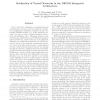Free Online Productivity Tools
i2Speak
i2Symbol
i2OCR
iTex2Img
iWeb2Print
iWeb2Shot
i2Type
iPdf2Split
iPdf2Merge
i2Bopomofo
i2Arabic
i2Style
i2Image
i2PDF
iLatex2Rtf
Sci2ools
IPPS
2006
IEEE
2006
IEEE
Realization of virtual networks in the DECOS integrated architecture
Due to the better utilization of computational and communication resources and the improved coordination of application subsystems, designers of large distributed embedded systems (e.g., in the automotive domain) are eager to replace existing federated architectures with integrated ones. This paper focuses on the communication infrastructure of the DECOS integrated system architecture, which realizes for each application subsystem a so-called virtual network as an overlay network on top of a time-triggered communication protocol. Since all virtual networks share a single physical network, virtual networks promise massive cost savings through the reduction of physical networks and reliability improvements with respect to wiring and connectors. Furthermore, virtual networks support application subsystems that range from ultra-dependable control applications (e.g., an X-by-wire system) to non safetycritical applications such as comfort systems. For this reason, two classes (event-trigger...
Application Subsystem | Distributed And Parallel Computing | IPPS 2006 | Time-triggered Communication | Virtual Network |
| Added | 12 Jun 2010 |
| Updated | 12 Jun 2010 |
| Type | Conference |
| Year | 2006 |
| Where | IPPS |
| Authors | Roman Obermaisser, Philipp Peti |
Comments (0)

